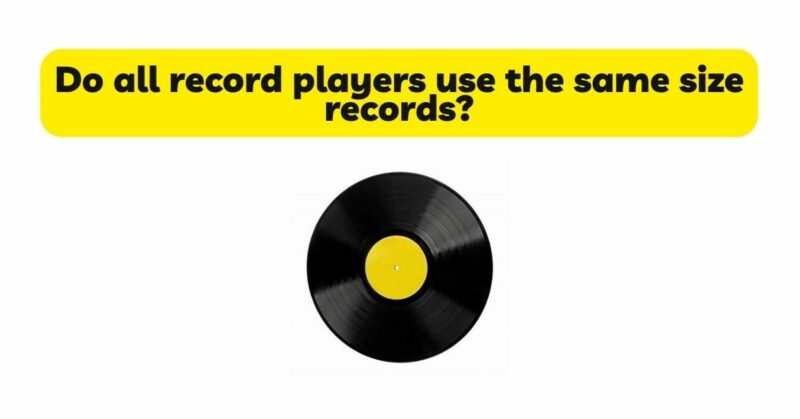Vinyl records have made a remarkable comeback, captivating music enthusiasts with their unique sound and tactile experience. As vinyl’s popularity continues to rise, questions arise about the compatibility between record players (turntables) and vinyl record sizes. Do all record players use the same size records? In this article, we will explore the variations in vinyl record sizes and discuss the compatibility between different record players and record sizes, shedding light on the nuances within the vinyl format.
Vinyl Record Sizes:
Vinyl records are available in various sizes, each serving different purposes or accommodating specific musical formats. The most common vinyl record sizes include:
- 12-inch LP (Long Play) Records: The 12-inch LP records are the most prevalent size for full-length albums. These records typically contain multiple tracks on each side and are played at a rotational speed of 33 1/3 revolutions per minute (RPM).
- 7-inch EP (Extended Play) Records: The 7-inch EP records, often referred to as singles, are smaller in size and usually feature one or two tracks per side. These records are played at a rotational speed of 45 RPM and are commonly used for single releases or shorter recordings.
- 10-inch Records: 10-inch records, although less common, fall between the 12-inch LP and 7-inch EP sizes. They were popular during the early days of vinyl records and can be found in both 33 1/3 RPM and 45 RPM formats.
Compatibility with Record Players:
Record players, or turntables, are designed to accommodate different vinyl record sizes. Most modern turntables feature interchangeable platters or spindle adapters that allow for easy switching between record sizes. This compatibility enables users to play a wide range of vinyl records on a single turntable.
The tonearm, which holds the cartridge and stylus, is designed to be adjustable in length to accommodate different record sizes. This adjustability ensures that the stylus tracks the grooves accurately for optimal playback quality. Additionally, turntables often have settings for adjusting tracking force and anti-skate to ensure proper stylus tracking for various record sizes.
It’s important to note that some older or specialty turntables may have fixed spindle positions, limiting their compatibility to a specific record size. Therefore, it’s essential to check the specifications of your turntable to ensure it can accommodate the record sizes you intend to play.
Specialty Sizes and Formats:
In addition to the common record sizes mentioned above, there are specialty sizes and formats in the vinyl world. These include:
- 5-inch Records: These mini records are typically novelty items or limited editions and are not widely used for standard music releases. They serve more as collector’s items or promotional tools.
- Picture Discs and Shaped Records: Picture discs feature unique designs or images embedded in the vinyl, while shaped records deviate from the standard circular format and take on various shapes. These specialty formats may have specific compatibility requirements due to their unconventional shape or added features.
- Box Sets: Box sets often contain multiple vinyl records of various sizes, including 12-inch LPs, 10-inch records, and sometimes even 7-inch EPs. These box sets are curated collections, limited editions, or special releases.
When playing specialty sizes or formats on your turntable, ensure that your turntable’s spindle adapter or platter is compatible with the specific size or shape of the record. Some specialty formats may require additional equipment or adjustments to accommodate their unique features.
Conclusion:
In conclusion, record players are designed to accommodate various vinyl record sizes, with the most common being 12-inch LPs and 7-inch EPs. Most modern turntables offer interchangeability of platters or spindle adapters, allowing forflexibility in playing different record sizes on a single turntable. The adjustability of the tonearm, tracking force, and anti-skate settings further ensure accurate stylus tracking for optimal playback quality. However, it’s important to check the specifications of your turntable, especially older or specialty models, as they may have fixed spindle positions that limit compatibility to specific record sizes.While the majority of vinyl records fall into standard sizes, specialty sizes and formats such as 5-inch records, picture discs, shaped records, and box sets also exist. These specialty formats may have specific compatibility requirements due to their unconventional size or shape. Before playing such records, verify whether your turntable’s spindle adapter or platter can accommodate the particular size or shape.Understanding the compatibility between vinyl record sizes and record players allows you to fully enjoy the diverse range of music available on vinyl. Whether you’re spinning a 12-inch LP or a 7-inch EP, the vinyl format offers a unique listening experience that continues to captivate music enthusiasts.


